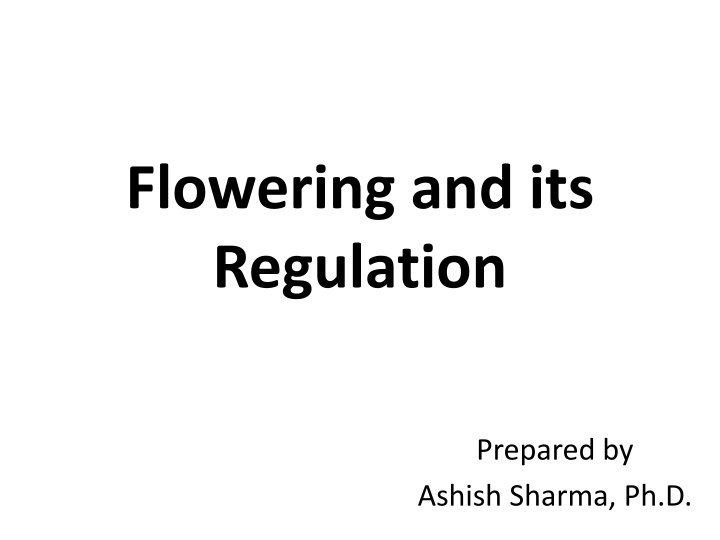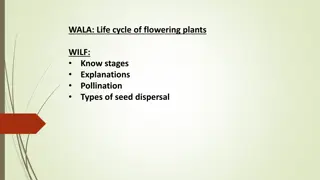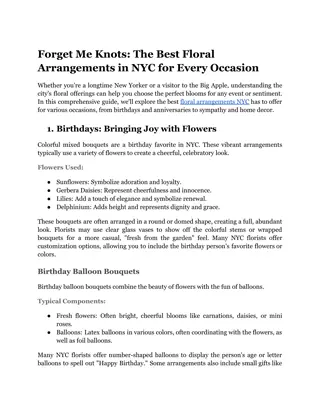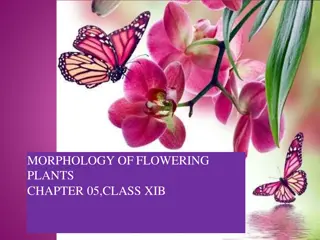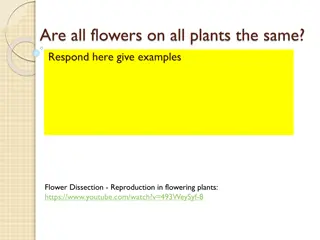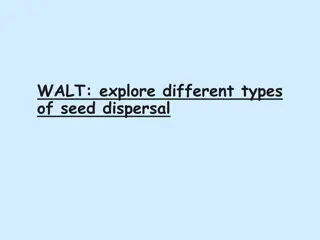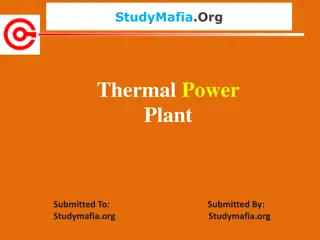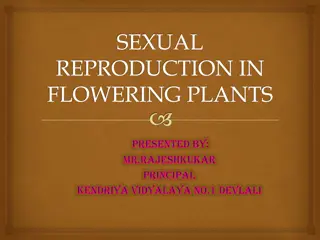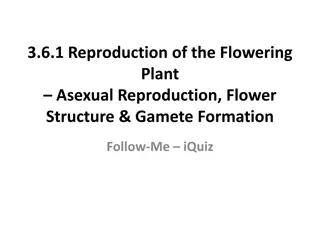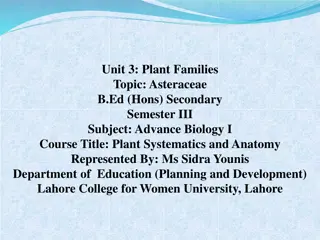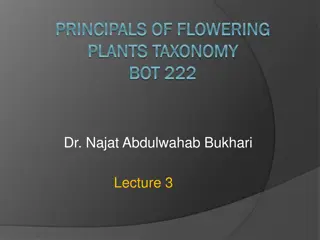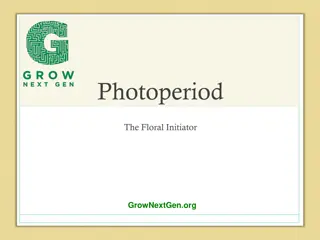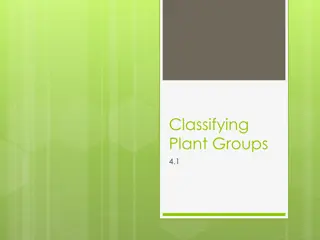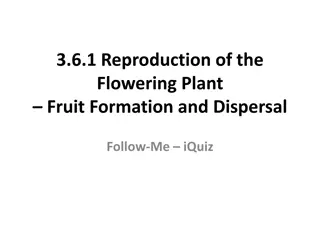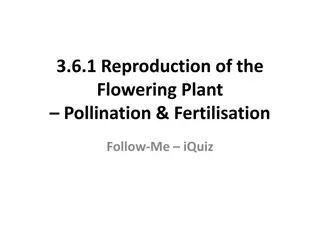Insights into Flowering and Floral Development in Plants
Plants regulate flowering through environmental signals perceived by the shoot apex, leading to radical changes in cell fate during floral evocation. Transition to reproductive phase involves floral meristem development, initiation of floral organs, and regulation by different gene types influencing floral identity and organ formation. Understanding these processes sheds light on the complex array of structures in flowers.
Download Presentation

Please find below an Image/Link to download the presentation.
The content on the website is provided AS IS for your information and personal use only. It may not be sold, licensed, or shared on other websites without obtaining consent from the author.If you encounter any issues during the download, it is possible that the publisher has removed the file from their server.
You are allowed to download the files provided on this website for personal or commercial use, subject to the condition that they are used lawfully. All files are the property of their respective owners.
The content on the website is provided AS IS for your information and personal use only. It may not be sold, licensed, or shared on other websites without obtaining consent from the author.
E N D
Presentation Transcript
Flowering and its Regulation Prepared by Ashish Sharma, Ph.D.
How do plants keep track of the seasons of the year and the time of day? Which flowering, and how are those signals perceived? environmental signals control How are environmental signals transduced to bring about the developmental changes associated with flowering?
Flowers represent a complex array of functionally specialized structures that differ substantially from the vegetative plant body in form and cell types. The transition to flowering therefore entails radical changes in cell fate within the shoot apical meristem. The events occurring in the shoot apex that specifically commit the apical meristem to produce flowers are collectively referred to as floral evocation.
FLORAL MERISTEM AND FLORAL ORGAN DEVELOPMENT Transition from vegetative to reproductive phase increase in the frequency of cell division. In Arabidopsis apical meristem produces phytomeres with very short internodes, resulting in a basal rosette of leaves during vegetative phase. Reproductive development - indeterminate primary inflorescence meristem secondary inflorescence meristem.
Floral meristems initiate four different types of floral organs: Sepals, Petals, Stamens, and Carpels
Three Types of Genes Regulate Floral Development 1. Floral organ identity genes directly control floral identity. 2. Cadastral genes act as spatial regulators of the floral organ identity genes by setting boundaries for their expression. 3. Meristem identity genes are necessary for the initial induction of the organ identity genes.
Meristem identity genes Necessary for floral organ initiation. Mutation leads to development of clusters of leaves. Different genes include: FLORICAULA (FLO), AGAMOUS-LIKE 20 (AGL20), APETALA1 (AP1), and LEAFY (LFY). FLORICAULA (FLO) gene controls the determination step in which floral meristem identity is established.
LFY performs similar function in Arabidopsis as FLO in Snapdragon. AGL20 serve as a master switch initiatingfloral development. AGL20 LFY AP1
FLORAL ORGAN IDENTITY GENES Arabidopsis: APETALA1 (AP1), APETALA2 (AP2), APETALA3 (AP3), PISTILLATA (PI), and AGAMOUS (AG). Because mutations in these genes change floral organ identity without affecting the initiation of flowers, they are HOMEOTIC genes. These homeotic genes fall into three classes types A, B, and C defining three different kinds of activities.
In 1991 the ABC model was proposed to explain how homeotic genes control organ identity. Activity of type A alone specifies sepals. Activities of both A and B are required for the formation of petals. Activities of B and C form stamens. Activity of C alone specifies carpels.
FLORAL EVOCATION: INTERNAL AND EXTERNAL CUES May flower within a few weeks or may not for a few years. Different species flower at widely different ages internal factor autonomous regulation. Some plants exhibit an absolute requirement for the proper environmental cues obligate or qualitative response. Absolute requirement for the proper environmental cues but occur in absence also facultative or quantitative response.
Photoperiodism and vernalization - two of the most important mechanisms. PHOTOPERIODISM - response to the length of day. VERNALIZATION promotion of flowering at high temperature by exposing plant to low temperature. The evolution of both internal and external control systems enables plants to carefully regulate flowering at the optimal time for reproductive success.
PHASE CHANGE During postembryonic development, the shoot apical meristem passes through three developmental stages in sequence: 1. The juvenile phase 2. The adult vegetative phase 3. The adult reproductive phase The transition from one phase to another is called phase change.
Transition from juvenile to adult involve changes in vegetative characteristics, such as leaf morphology, phyllotaxy, thorniness, rooting capacity, and leaf retention in deciduous plants.
Size of the plant rather than age is more important in terms of phase change. One adult phase has been attained it persists. Phase change can also be influenced by nutrients, gibberellins and other chemicals (such as carbohydrates). Other important features that produce flowering in green plants are competence and determination.
A bud is said to be competent if it is able to flower when given developmental signal. the appropriate A bud is said to be determined if it progresses to the next developmental stage (flowering) even after being removed from its normal context.
PHOTOPERIODISM: MONITORING DAY LENGTH Allows for a seasonal response. Found in both animals and plants. A number of responses are influenced by day length in plants, including The initiation of flowering, Asexual reproduction, The formation of storage organs, and The onset of dormancy.
The phenomenon was demonstrated by Garner and Allard (1920s) and they divided the plants into following broad categories: Short-day plants (SDPs) flower only in short days (qualitative SDPs), or their flowering is accelerated by short days (quantitative SDPs). Long-day plants (LDPs) flower only in long days (qualitative LDPs), or their flowering is accelerated by long days (quantitative LDPs).
Some plants sense dual day length Long-short-day plants (LSDPs) flower only after a sequence of long days followed by short days. Egs: Bryophyllum, Kalanchoe, and Cestrum nocturnum 2. Short-long-day plants (SLDPs) flower only after a sequence of short days followed by long days. Egs: Trifolium repens (white clover), Campanula medium (Canterbury bells), and Echeveria harmsii (echeveria)
Species that flower under any photoperiodic condition are referred to as day-neutral plants. Day-neutral plants (DNPs) are insensitive to day length. Flowering in DNPs is typically under autonomous regulation that is, internal developmental control. Egs: Phaseolus vulgaris (kidney bean), Castilleja chromosa (desert paintbrush) and Abronia villosa (desert sand verbena)
Plants can perceive either night or day length. A small break in dark period can inhibit flowering in SDPs. Leaf is the site that senses photoperiod photoperiodic induction. Photoperiodic stimulus can be transferred. Floral stimulus is transferred by the phloem. Phytochrome regulates photoperiodic response.
VERNALIZATION: PROMOTING FLOWERING BY COLD Vernalization is the process whereby flowering is promotedby a cold treatment given to a fully hydrated seed or to a growing plant. Plants differ considerably in the age at which they become sensitive to vernalization. The effective temperature range for vernalization is from just below freezing to about 10 C.
The response usually requires several weeks of exposure to low temperature, but the precise duration varies widely with species and variety. Vernalization can be lost as a result of exposure to devernalizing conditions, such as high temperature. Vernalization appears to take place primarily in the shoot apical meristem. In developmental terms, vernalization results in the acquisition of competence of the meristem to undergo the floral transition.
